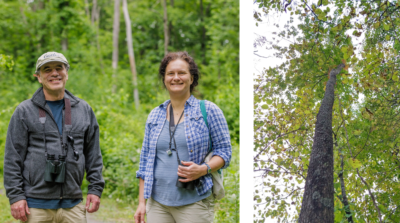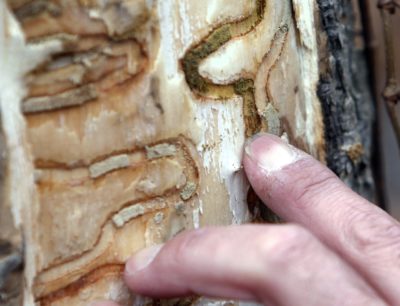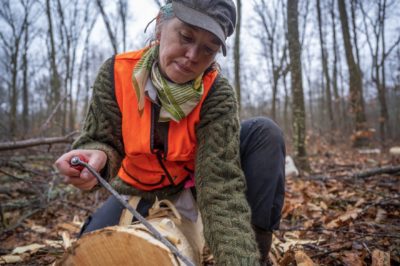The tree Radka Wildova and Jonathan Rosenthal needed to indicate me was only some hundred toes from the path at Tivoli Bays, a state wildlife administration space in Rhinebeck, New York. However attending to it required bushwhacking by means of a thicket of non-native honeysuckle, multiflora rose, and poison ivy. “It’s like a museum of invasives right here,” Rosenthal, an ecologist primarily based in close by New Paltz, noticed as we stumbled by means of the underbrush.
The tree, as soon as reached, was perhaps 100 toes excessive and ten inches in diameter. It was sporting a metallic tag that recognized it as quantity 047. “This can be a inexperienced ash,” Wildova, a botanist who’s additionally primarily based in New Paltz (and is Rosenthal’s spouse) introduced. Ash timber are dioecious, which means they produce both all male or all feminine flowers.
“I feel it’s a she,“ Wildova mentioned. “However they don’t flower yearly, so it may be laborious to inform.”
What was distinctive about tree quantity 047 was that it was not simply alive, however wholesome. Since emerald ash borer beetles had been first launched to america, in all probability within the Nineteen Nineties, lots of of hundreds of thousands of timber have died. Within the Hudson Valley, the overwhelming majority of ash have succumbed.
At some point, scientists hope, borer-resistant timber will present seeds to interchange a few of the hundreds of thousands of ash which have been misplaced.
However a really small proportion of ash timber — perhaps 1 % — appear to be resisting the beetles. These have change into often called “lingering ashes,” and Wildova and Rosenthal routinely courageous poison ivy for them.
The 2 run a program known as Monitoring and Managing Ash, which fits by the acronym MaMA. (“Our tagline is ‘Come to MaMA,’” Rosenthal joked to me.) This system trains state and native officers and residents how you can determine lingering ashes and likewise collects samples from resistant timber.
Over the winter, Wildova recounted, she had clambered out to quantity 047 carrying a pruning noticed connected to an extended pole. With the noticed, she had reduce a small department from the tree. “You need to do it when the timber are dormant,” she defined.
The department had been despatched out to be grafted onto ash root inventory to develop a brand new child tree, which had then been despatched to a greenhouse at Cornell College. When the tree is sufficiently old to supply flowers — feminine ones, presumably — it will likely be crossed with one other lingering ash to supply timber that, it’s hoped, will likely be much more immune to emerald ash borers than its dad and mom. At some point — so the hope additional goes — these resistant timber will present seeds to interchange a few of the hundreds of thousands of ash which have been misplaced. The same effort has been underway for a number of years on the U.S. Division of Agriculture’s analysis station in Delaware, Ohio. A number of the timber in Ohio at the moment are being field-tested. (Since ash timber are regionally tailored, it gained’t be sufficient to develop one number of E.A.B.-resistant ash; many types will likely be wanted.)

Left: Researchers Jonathan Rosenthal and Radka Wildova. Proper: “Lingering ash” quantity 047 in Tivoli Bays wildlife administration space in New York.
Radka Wildova; Jerry Monkman / EcoPhotography
“There are 5 phases of grief, and certainly one of them is resignation, which it looks as if an enormous variety of persons are at,” Rosenthal mentioned. “Folks will say, ‘These timber are disappearing,’ and so they’ll write them off. So we’ve discovered that the easiest way to interact with them and get them truly to do one thing, is to allow them to know that there’s hope and there are issues that may be finished.”
Emerald ash borers, or E.A.B.’s as they’re usually known as, are about half an inch lengthy with shimmering inexperienced wings. The beetles, that are native to China, Korea, and japanese Russia, possible had been launched to the U.S. by means of contaminated delivery crates or picket pallets. They had been first detected in Michigan in 2002 and by now have unfold all through the Midwest, New England, the Mid-Atlantic states, and far of the Southeast. In 2022, the primary inhabitants was detected on the West Coast, in Oregon.
Ash are a vital element of Jap forests; in locations like north-central Vermont, they make up greater than 1 / 4 of the tree cover. The timber’ seeds are an essential meals supply for birds and small mammals, and their leaves decompose extra rapidly than these of timber like oak, so they’re key to nutrient recycling. Dozens of insect species rely on ash, and lots of are related to ash timber. If these timber are misplaced, creatures that depend on them may very effectively be pushed to extinction.
In accordance with a latest paper, the emerald ash borer is “essentially the most damaging and expensive invasive forest insect” North America has seen.
“There isn’t a rescue island,” is how David Wagner, a professor of ecology and evolutionary biology on the College of Connecticut, has put it. In accordance with a latest paper by researchers on the U.S. Military Corps of Engineers, E.A.B. is “essentially the most damaging and expensive invasive forest insect” North America has seen.
Ash, in the meantime, is not only one tree, however an entire group of them. (Curiously sufficient, nobody is aware of precisely what number of species of ash there are in North America; estimates run from 15 to 25.) Most species appear to be weak to E.A.B., together with inexperienced ash, white ash, and black ash, every of which is important for various causes, ecological and cultural.
Inexperienced ash are fast-growing and pollution-tolerant. Consequently, they had been usually planted in city settings after Dutch elm illness swept by means of. (It’s been estimated that eradicating and changing city ash timber may find yourself costing cities greater than $12 billion.) White ash is among the few native timber species that’s able to rising up by means of the thicket of non-native crops that now varieties the understory in lots of Jap forests. So with out them, extra forests might change into “museums of invasives.” For many of baseball historical past, bats had been manufactured from white ash. (Now wooden bats are primarily constructed from maple.)

Tunnels carved by emerald ash borer larvae beneath the bark of an ash tree.
Mike Groll / AP Picture
Black ash reside in swamps and play a key function of their habitat’s hydrology; when the ash die, the swamps might flip to open water. Black ash can also be central to many Indigenous cultures; its wooden has particular properties that make it prized by basket-makers. In accordance with certainly one of their creation tales, the Wabanaki folks, whose territory as soon as included a lot of New England and southeastern Canada, emerged from an arrow shot right into a black ash tree.
For all these causes, E.A.B. would by itself depend as an ecological catastrophe. However in its assault on Jap forests, it has loads of firm. American chestnut timber had been roughly worn out in within the first half of the 20th century by chestnut blight, a fungal pathogen launched from Asia. (Contaminated timber had been first seen on the Bronx Zoo in 1904.) Dutch elm illness, one other fungal pathogen, killed off a lot of the U.S.’s elm timber within the center a part of the final century. (Regardless of the identify, Dutch elm illness in all probability additionally got here from Asia.) Jap hemlocks at the moment are in danger from woolly adelgid, bugs launched from Japan, whereas beech timber are threatened by beech bark illness, attributable to an insect, and likewise by beech leaf illness, attributable to a nematode.
“These timber are being pulled proper out of the forest by these forest pests and pathogens,” Leigh Greenwood, director of The Nature Conservancy’s Forest Pest and Pathogen Program, mentioned. “In some locations, you get native tree regrowth that gives comparatively good compensation, although you’re nonetheless lacking the biodiversity. However somewhere else, you don’t get good compensation, after which the entire ecology begins to break down on itself.”
Invasive pests do effectively as a result of they’ve left their predators behind. One strategy to combat them is to import their pests to pester them.
Lately, The Nature Conservancy introduced a new initiative, “Timber in Peril,” geared toward accelerating efforts to breed resistant ash, elms, hemlocks, and beeches. Among the many teams which have acquired funding from the initiative, which is supported by a $4.7 million grant from the New York-based Manton Basis, are MaMA and the ash breeding program at Cornell. The mission will even finance masters, PhD, and postdoctoral positions for specialists who can stick with it the breeding mission, which, it’s anticipated, will take many years.
“That is generational work for the people in addition to the timber,” she mentioned.
Invasive pests usually do effectively as a result of they’ve left their predators behind. One strategy to combat them — a way known as biocontrol — is to import their pests to pester them. On a separate observe, scientists are working to assist ash by spreading bugs that kill E.A.B.
On an attractive day not way back, I joined Claire Rutledge, an entomologist with the Connecticut Agricultural Experiment Station, to observe the outcomes of a few of these efforts. We met up at a farm in Kent, Connecticut. Rutledge had marked the ash timber she needed to examine with orange tape.

Entomologist Claire Rutledge cuts bark from an ash tree seeking emerald ash borer larvae.
Tyler Russell / Connecticut Public
As quickly as the hazards of E.A.B. had been acknowledged, researchers with the U.S. Division of Agriculture went on the lookout for the beetles’ pure enemies. They discovered three of them in northeast China — all parasitic wasps. One of many wasps didn’t do effectively within the chilly, so the researchers went to Russia to discover a hardier species. Many biocontrol efforts have gone awry, so the wasps underwent rigorous testing to ensure they didn’t additionally assault native bugs. On the conclusion of this testing, the E.A.B. predators had been launched at lots of of web sites within the Midwest and the Northeast, together with a number of in western Connecticut. Lots of the introductions had been profitable sufficient that the wasps have multiplied and unfold. (The wasps nonetheless may trigger injury the researchers didn’t anticipate; sadly, that is very troublesome to observe and, as soon as the wasps have established themselves, much more troublesome to do something about.)
On the farm in Kent, Rutledge was checking to ensure the populations had survived the winter and had been reproducing. The taped timber had been all nonetheless alive, although not for lengthy. An assistant of Rutledge’s reduce down one with a chainsaw; it was about 40 toes excessive and perhaps six inches in diameter. Rutledge started slicing away at its bark with a two-handled drawknife. “This can be a fairly contaminated tree,” she mentioned.

A parasitic wasp, Spathius galinae, probes ash bark for emerald ash borer larvae.
Jian Duan / USDA
Feminine emerald ash borers lay their eggs on the bark of ash timber. When these hatch, the larvae bore by means of the bark and begin consuming the vascular tissue beneath. As they eat their approach alongside, the larvae type tunnels that run up the facet of the tree in a collection of switchback-like curves. An ash might be able to survive a couple of of those tunnels, however sufficient of them disrupts the movement of vitamins and the tree dies. Rutledge was excited to discover a clutch of wasp cocoons in one of many tunnels she sliced by means of. “Cool,” she mentioned.
The cocoons, from the species Spathius galinae, seemed like tiny grains of rice. Rutledge defined that the wasps’ mom had deposited her eggs inside an E.A.B. larva. When these eggs had hatched, the wasp larvae had then eaten their approach by means of the beetle larva, killing it. That they had now pupated, and, had they been left alone, would have emerged as grownup wasps.
Extra slicing yielded a E.A.B. larva in its third instar, which means it had molted twice. At this stage, the larva was in all probability protected from predation. “This can be a third and it appears completely comfortable, sadly,” Rutledge mentioned.
When beetle numbers are excessive, the launched wasps aren’t any match for E.A.B. The hope is that as mature ash timber die and beetle numbers decline, the launched wasps will preserve the E.A.B. inhabitants low sufficient that even non-resistant saplings will be capable to survive. Rising a mature ash is a sluggish course of, although, so it will likely be many years earlier than it’s clear whether or not this hope will likely be realized.
Within the meantime, sadly, extra threats to Jap forests are certain to emerge. Just some years in the past, a brand new imported pest, the elm zigzag sawfly, was detected in Virginia; it’s now in not less than 4 extra states: Maryland, Pennsylvania, North Carolina, and New York. As the web site Entomology In the present day put it in a publish on the sawfly: “Right here We Go Once more.”
